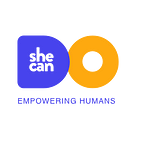Creating a design portfolio: tips from the She Can Do community
There’s a lot of information out there about portfolios for designers and yet many questions still remain. What should you include? How best to include it? How much information is enough and how much information is too much? What’s the best format to create it in? Should it be a website or just a few case studies on Dribble?
A She Can Do member recently shared her portfolio with our Slack community to get honest and constructive feedback. We were lucky enough to get really nice Dos and Don’ts from Alex Oloo, Design Director at Absa bank (spending much of his time looking at portfolios, and therefore qualified to provide excellent advice).
His feedback was too insightful to keep to ourselves. So, with his permission, we’ve compiled them all in this article.
First and foremost, says Alex, you should consider the holistic picture of attracting attention in order to get your portfolio in the right hands. Let’s explore how to get your ‘digital profile’ to where it should be.
Recruiters are often the first chain in the hiring process. Keep in mind that they tend to look/go through large volumes of applicants, so it’s important to make a good first impression. We don’t necessarily agree with this, but these are the things that they look for:
- Does your CV/LinkedIn contain the right keywords e.g. UX, UI, Designer, Design, etc?
- Demographic information
- Approximate age: specifically are you too young or too old for the role in their eyes?
- Do you have work experience?
- Do you have relevant work experience and, if so, how much?
- Is your experience with a recognised or serious-seeming company?
- Did you study? And if so, what?
- If contracting, what is your rate?
At this point, you generally make it onto some sort of shortlist and they’ll look through your CV.
CV
- Don’t include your full address, rather just the city or country for safety reasons. Don’t include your ID number or marital status either — you’d be surprised what fraudsters can do with that information.
- Assume the person knows very little about design so don’t overwhelm them with text. Easy to understand lists are helpful.
- Don’t include high school information as it is no longer relevant once you have a degree.
- If your LinkedIn profile and CV make a good impression, hirers will take a look through your portfolio or send it on to someone else to look through.
Finally, your portfolio
- With your portfolio, you can assume that your CV has generated some interest so you have more freedom to go into detail.
- That being said, don’t include every piece of work you’ve ever done. Focus on the ones that illustrate your skills, best results, and best thinking.
- Your portfolio as a whole should make it apparent what your core/desired discipline is.
- Human beings tend to assume beautiful work is good work. Make sure your portfolio looks great. Even though your rough work should look rough, it should still be put together well.
- Start with your profile by introducing yourself.
- End with your contact card and a call to action.
- Restrict yourself to at most 3–4 pages per piece of work. A good starting point could be:
- Section/Page 1: Client, objective, approach, outcome/results (as this is generally light on content, a recommendation is to support this section with eye-catching images)
- Section/Page 2: Research, personas, insights
- Section/Page 3: Journey/Wireframes
- Section/Page 4: UI/Highest fidelity
One last tip
Triple check your contact details and ensure they’re accurate and up-to-date across all channels. You could be a solid candidate, but if you can’t be reached (as a result of not including any details, listing too few digits in your phone number or an incorrect/old number), you could be losing out on potential opportunities.
